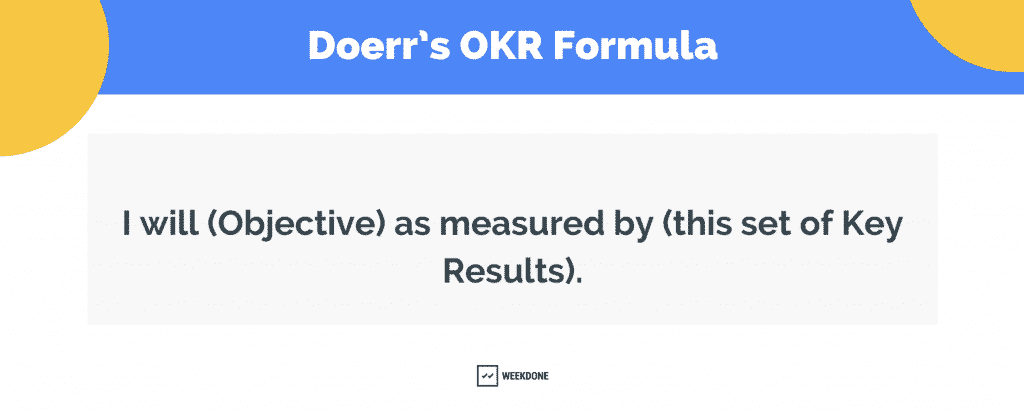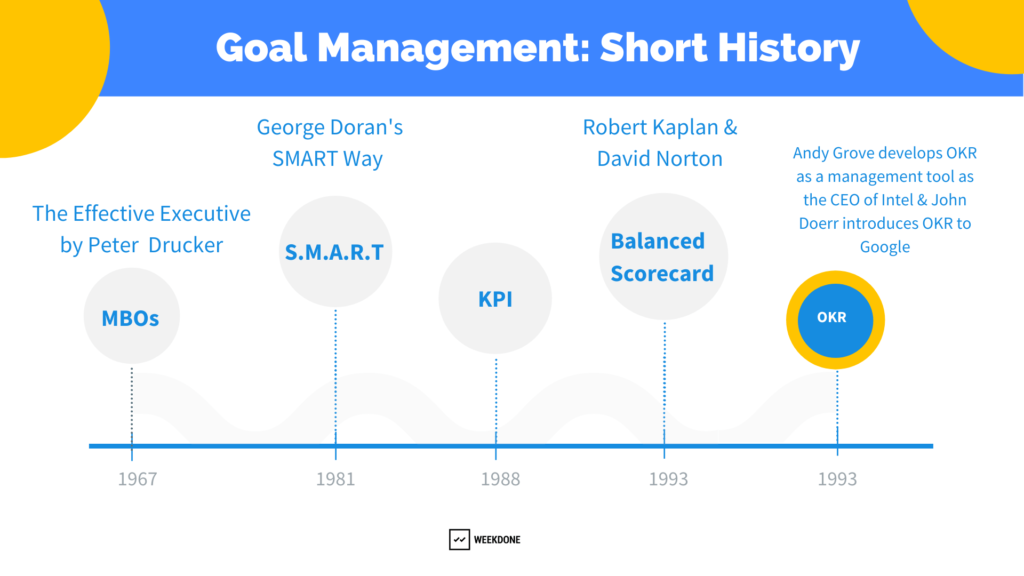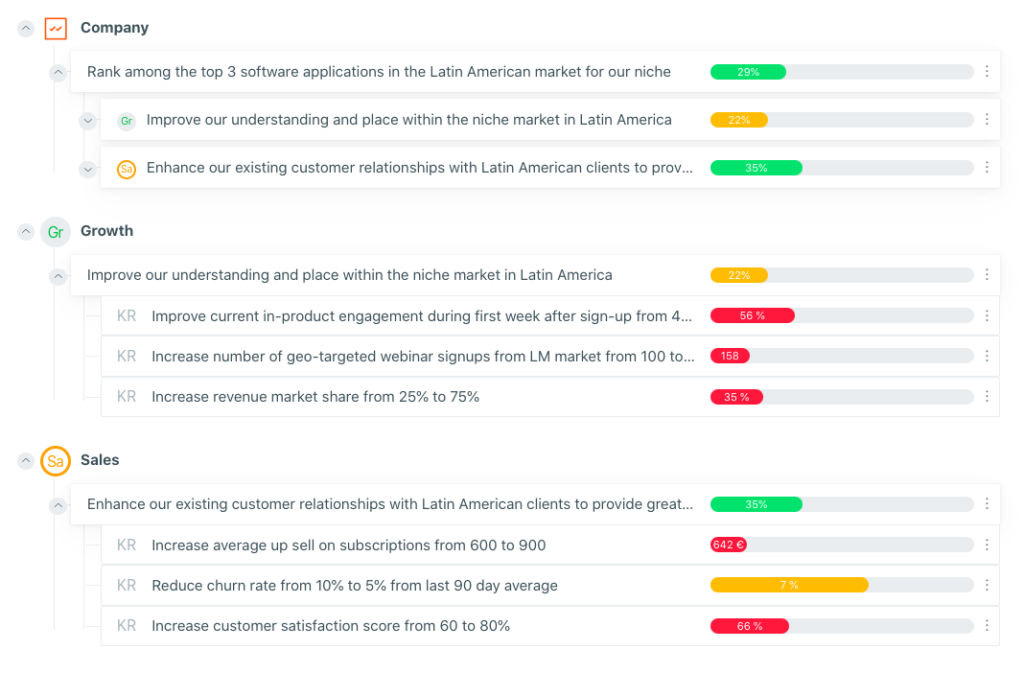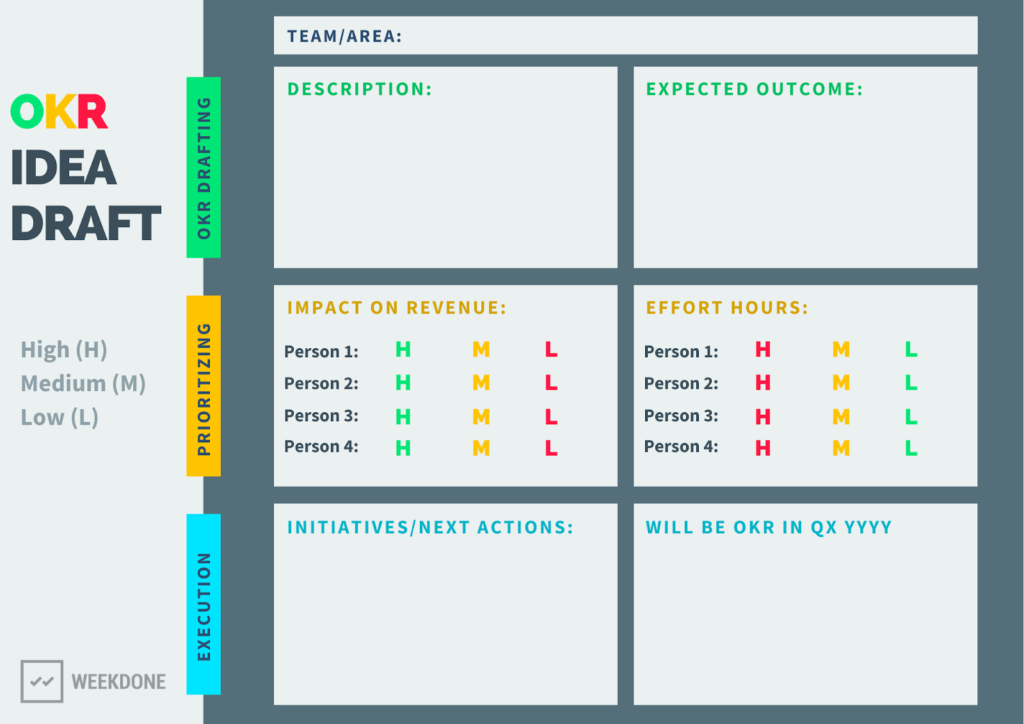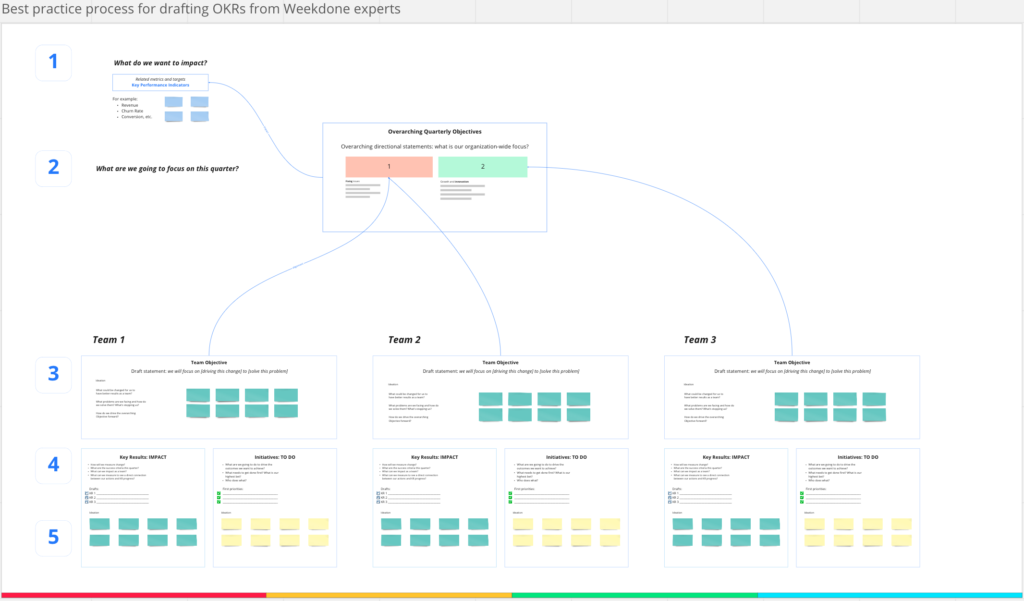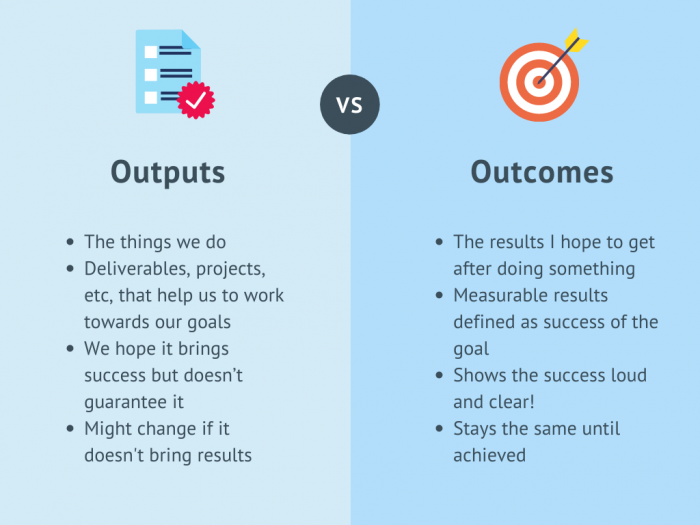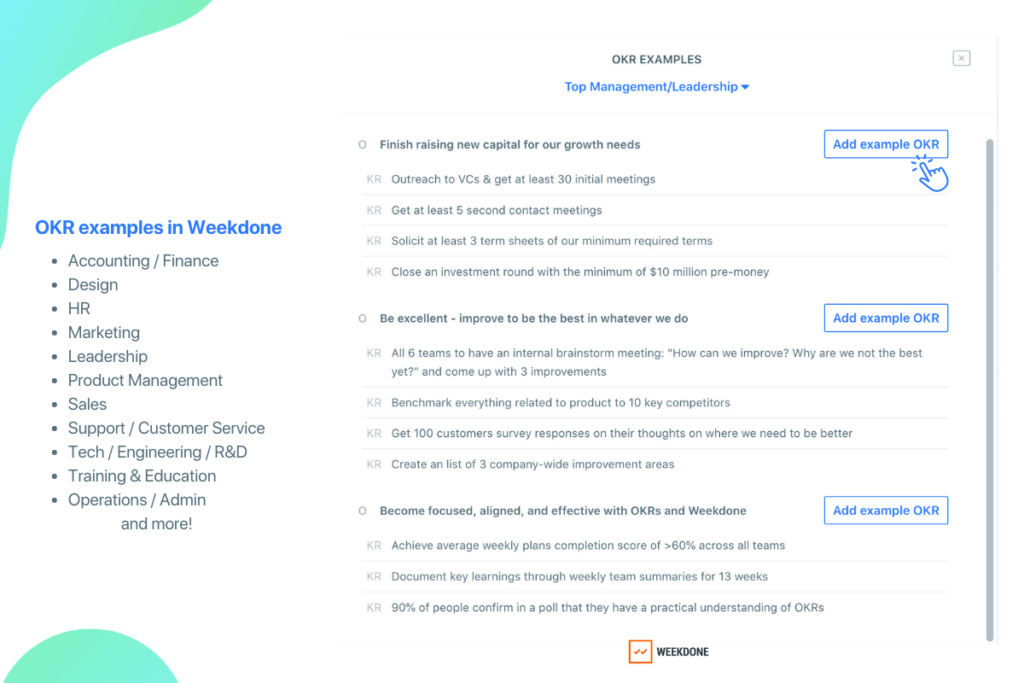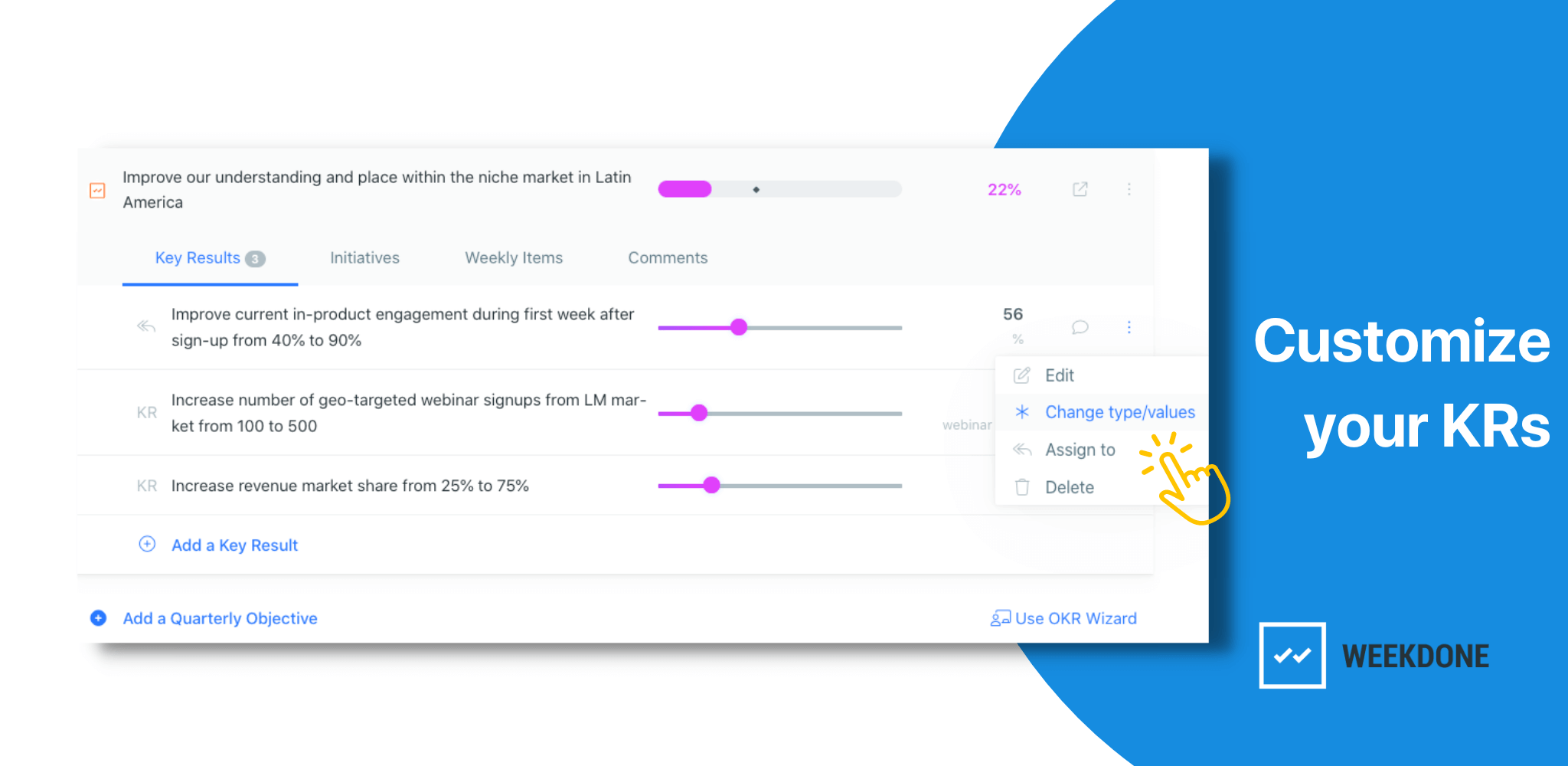Welcome to the simplest breakdown of the OKR methodology.
This article is written for anyone and everyone looking to make more informed and strategic business decisions supported by real results over impulse.
OKR definition
The definition of OKR is defined by John Doerr as, “a collaborative goal-setting protocol for companies, teams, and individuals”. Measure What Matters.
OKR is an acronym for Objectives and Key Results. The popular framework helps companies to streamline the overall vision, strategy, and business goals – from the C-suite to individual employees.
The meaning of OKR
As mentioned, the meaning of OKR is Objectives and Key Results.
Objectives are inspirational, qualitative statements and should be set at the company and team levels. Individuals can also set their own objectives, however, in the business setting it is not a recommended best practice.
Key results are measurable benchmarks. They are the qualitative values that explain whether or not you’ve met the connected objective.
Objectives and key results work together, and so should your teams. When adopted by the entire organization, OKRs will help everyone understand how to drive the most meaningful business improvements through focused team efforts in the short run.
Read about personal vs team OKRs
History of OKRs
In 1970 the goal management framework, Objectives and Key Results, was introduced to businesses through CEO of Intel, Andy Grove. The idea takes MBO a few steps further by adding measurable key results, and growing the collaboration factor from management only to include everyone.
In 1993 Grove introduced the methodology to John Doerr, who shared it with Google, where the company’s first objective was to become “THE systematic innovator at scale”.
It’s clear that Google has made a name for itself, not only for their business achievements, but also their successful management style – making employees feel seen, appreciated, and believing in the impact of their work.
Alternative OKR methodologies
SMART goals:
SMART stands for Specific, Measurable, Achievable, Realistic, and Time-bound.
The SMART framework helps you write better goals, and think critically about the intent of your objective – however, it doesn’t consider the steps that goes into achieving that goal, like the key results for OKRs do.
Management by Objectives (MBO):
Management by Objectives is a top-down management technique used by leaders to define objectives for individual employees in order to drive organizational performance.
The MBO framework is often connected to employee compensation and annual performance reviews. Because of this connection, the objectives set within the MBO framework become more achievable targets, rather than stretch goals that inspire individuals to go beyond their potential.
The OKR methodology differs from MBO in this way – as good OKRs are ambitious goals that spark individuals to reach further than their perceived limitations in order to contribute to the success of the company. Unlike MBO, OKRs work best when set, tracked, and revised (as needed) during one quarter – they are agile yet focused. MBO is focused on the final result at the year’s end with less connection to the “how” it is achieved.
Balanced Scorecard (BSC):
Many companies use the Balanced Scorecard as the means for measuring business performance and success. The BSC method helps managers bring focus toward the long-term company strategy and vision by breaking it down into 4 perspectives:
- Financial
- Internal processes
- Growth
- Customer relationships
Strategic goals are then determined through a review process of workshops and interviews where management discusses the perspective areas that require the most attention.
How to use OKRs
The OKR system works best when the entire organization buys into the methodology. This buy-in ensures that everyone – from the CEO to team leaders and individual employees – understands the benefits of OKRs.
OKRs require a mindset shift in order to gain those benefits and make the most out of the transition to better goal management.
Getting started + operating the OKR cycle
Objectives and key results require 4 step cyclical process that should be repeated each quarter during a year.
By following this OKR cycle, you’ll encourage:
- team alignment,
- employee engagement,
- and keep focus on the right agile goals at the right time.
But first, how many OKRs should be set for the company, and teams?
Ultimately, how many OKRs you set will depend on the structure of your organization. However, a good rule of thumb to follow goal alignment best practices:
- Set one overhead company objective, with corresponding individual team objectives and their measurable key results.
Each team should have no more than 3 objectives, with each objective having 3-5 key results to measure that progress.
We recommend the “less is more” approach here. With 1 objective as measured by 3-5 key results, a team should have plenty of ideas on how to make progress towards those ambitious goals throughout the quarter.
So, how do OKRs work?
First, get started with the proper implementation strategy, and then follow the OKR cycle, as broken down below.
Before the cycle: OKR implementation
When considering how to implement OKRs, the plan you choose to move forward with in your company depends on who will be using the OKR methodology. Any new internal processes need proper introduction with a well thought out action plan. At Weekdone, we recommend 1 of 3 strategies for this process.
Each of the following strategies explains who, and how the framework will be shared across the entire organization after some time.
- Pilot team
A pilot team is a chosen group of individuals who first learn the methodology for themselves and later “champion” the process once they have the complete company buy in.
The pilot team doesn’t have to be one team (i.e. Marketing or Sales), it is often individuals from different teams – those with a growth mindset. The pilot team consists of the people ready for a challenge – to learn, test, and share the framework with others when the time is right.
- Team leaders only
This strategy will require each team leader from different teams or departments to take on the process of learning, testing and sharing their knowledge of OKRs with their team when the time is right.
The team leaders only approach works best for businesses who know they will implement OKRs company-wide in the upcoming months. By taking this approach, everyone can see how OKRs align with the company objective in a practical way. This creates the cross-team collaboration and communication that the framework intended.
- Everyone
A company wide OKR roll-out has some more moving parts, and therefore requires at least one person to be the guide, monitoring the process. Depending on the size of your organization it may be more than one. This is your OKR champion.
An OKR champion is your go-to person who is ready to answer questions as they arise – they should understand how OKRs work for each level of the company.
This “everyone all-in” strategy is good for SMBs with a flat hierarchical structure.
Weekdone experts can guide your implementation process and beyond. Our registered software users receive unlimited trainings and coaching sessions.
The OKR cycle
1. Planning and writing your OKRs
In the planning phase, teams have a chance to set goals that measure how their work contributes to the big picture company objective.
Before teams set their OKRs for the quarter, the company level objective should have been discussed and agreed upon by the management team and placed “on the wall” for everyone to see. This acts as the guiding light for teams as they begin thinking of what they want to achieve in the quarter that will drive this objective forward.
The planning stage for team OKRs should center around discussion, asking questions like:
- What is the expected outcome of our team efforts?
- How will our time and effort impact the company revenue (or other business driven KPIs)
- What big projects or out of the box ideas can we execute to move the needle forward?
Bonus: Free templates for teams + company OKR planning:
Once the team OKRs are set, agreed upon and shared with the company, they need to be written somewhere for everyone to see in order for the next stages of the cycle to work correctly.
You can use one of 2 options:
Whichever you choose is up to you, just be sure that everyone has access and makes a habit of regularly checking in on progress.
Key things to remember when writing OKRs are:
Objectives are the qualitative, aspirational statements.
Think ‘stretch goals‘. These are the goals that you would be proud to accomplish at least 70% by the end of quarter. If you’re reaching 100% success quarter after quarter, you’re not reaching far enough.
Key results are quantitative measurements that help determine whether your team is driving impact toward the objective
These comparative benchmark metrics are not KPIs. KPIs are Key Performance indicators – the numbers you’re actively tracking in a year – think revenue and sales goals, or 1 shot targets.
A good key result is one that directly influences the success of your objective, which changes quarterly. So if you’re tracking the same numbers as a key result over and over, ask yourself what else could you impact?
Write for others not on your team
This means that Product should understand what Marketing is trying to achieve. Are you wording your objectives and key results in a way that is understandable to anyone? If not, you should!
OKRs are not projects
Initiatives are projects. Initiatives are part of the execution, the outputs. Initiatives are your 1-3 month innovative ideas that you’ll implement to really force the OKR forward. Bringing you closer to the outcome you set to achieve.
Focus on the outcome not output
Outputs are the things you do to get things done. They are the tangible elements created that you hope will make an impact on your OKR. Outputs = initiatives, projects, and weekly plans. Outcomes is the potential (measurable) impact made from those efforts AKA key results.
This article shares how to write good OKRs or check out how the OKR wizard writing assistant in Weekdone can help
2. Weekly OKR check-ins
A weekly OKR check-in is exactly what it sounds like – an opportunity for you to connect, ideate and communicate with your team members on a weekly basis. This is a great opportunity to discuss progress (or lack of) made on a team OKR and find common solutions or new ways forward.
An OKR check-in is not your weekly sprint. Therefore, you must avoid getting stuck in the habit of sharing business as usual tasks, but rather discuss whether your current initiatives are working, or what you can do to move ahead. By asking questions directly related to the OKR, you’ll make sure everyone keeps focus on the right goals.
Read more about the Weekly OKR check-in here
The OKR software or template you agreed to use in the last step will help everyone to stay transparent and accountable to achieve the work they’ve planned to get done.
3. Monthly OKR Review
An OKR review happens on a monthly basis. This is the opportunity for everyone who works on OKRs to gather together on a higher level and communicate ideas and current progress as one.
This meeting is best facilitated when each team leader or department head shares learnings from the month. They can additionally discuss new initiatives, or plans going forward. Other leaders and individual employees are encouraged to ask questions, engage, and start discussion here.
Plan these meetings on a reoccurring monthly basis, everyone should be able to prepare, know what to look at and be ready to listen and ask critical questions.
4. Quarterly retrospective
Finally, the quarterly retrospective. As you can guess, this is a meeting focused on what happened in the quarter. It’s best if this meeting happens in either the final week of the quarter, or the first week of a new quarter.
Read more on how to conduct a successful quarterly review
5. Repeat the OKR cycle
Once the quarterly retro meeting is finished and you’re familiar with the focus area for the next you can start back at point 1 of the cycle.
As you get more familiar with OKRs, you’ll begin to find yourself working quicker in the planning and writing stages.
Additionally, tracking and reviews become more streamlined with dashboards and gamification features provided by dedicated OKR software which offer integrations with tools you already use + improve connectivity across the board.
OKR examples
Once you start writing and implementing OKRs, you’ll see that there is more consideration that goes into creating a time bound, strategic goal using learnings, applicable metrics and forward thinking focus areas of improvement.
At Weekdone, we understand that examples are one of the most practical means for first time OKR users. So, here are 3 OKR examples, one for each level of an organization + how to use Weekdone’s OKR examples feature.
Company Objective:
Become the best software application in the Latin American Market for our niche.
Growth Department OKR:
Objective: Improve our understanding and hold on the niche market in Latin America
Key result 1: Improve current in-product engagement of users in target market during first week of sign up from 40% to 90%
Key Result 2: Increase number of geo-targeted webinar signups from LM market from 100 to 500
Key Result 3: Increase revenue market share from 25% to 75%
Sales OKR:
Objective: Enhance our existing customer relationships with Latin American clients to provide the greatest value possible
Key result 1: Increase average up sell on subscriptions from 600 – 900 euro
Key Result 2: Reduce churn rate from 10% to 5% from last 90 day average
Key Result 3: Increase customer satisfaction score from 60% to 80%
In this example, we used the goal alignment best practices, where each team is guided by the company objective to better write their OKRs. The business improvement is to bring focus toward improving a specific market, so everyone moves forward with that in mind.
From this, everyone can keep an eye on the big picture as they go forward with day to day tasks. Though OKRs are not task management – the methodology does help individuals get more done through prioritizing only the most important weekly activities.
OKR examples in Weekdone
Whether it’s your first quarter working with the framework, or you’re a seasoned OKR specialist, creating a good OKR can take some time.
Weekdone simplifies the process for your team by including OKR examples directly in the product.
🗂 Choose your ‘team OKR overview’
👆 Click to ‘add an objective’
👀 ‘See OKR examples’ to get inspired
📝 Or, use the OKR wizard as your personal writing assistant
Make an impact with Weekdone
There will always be something to learn when introducing a new framework to your employees. Weekdone offers a full learning center with tons of video and reading material to support our users. We make it our mission to set you up for success, even past your first days.
To learn more about how Weekdone can benefit your company’s transition to OKRs, book a demo with our experts. Or start your 2-week trial to test Weekdone and all it’s features.
